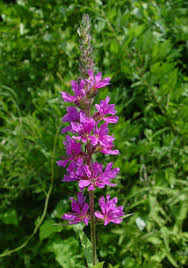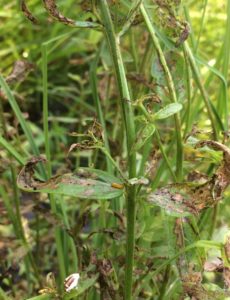Purple Loosestrife
Purple Loosestrife (PL)
Where is PL from and how did it get here?
PL is a wetland plant native to Europe and Asia. It was introduced to North America in the 1800s, likely carried over either unintentionally via its very small seeds, or intentionally as an ornamental.

PL plant
How do I identify PL?
Depending on the age and maturity, PL plants can be 2-7 feet tall. Each plant can have up to 50 stems. Stems are usually square with opposite leaves. Flowers grow close to the stem with 5-6 purple/pink petals. PL blooms late in the summer, usually August-September. PL’s seeds are smaller than a pin prick, and each plant can produce millions of seeds that easily float in the water, and can stick to boots and other gear without owner’s knowing.
Please contact our Water Program Coordinator if you think you have found PL.

PL flower. 5-6 petals on each flower, flowers growing close to the stem

PL leaves and stem: leave grow opposite on square stems
PL is most often confused with fireweed. Fireweed does not have a square stem, and its flowers grow further away from the stalks.

Fireweed, most commonly mistaken for PL. Note that flowers have 4 petals, and grow farther away from stem than PL flowers. Leaves are not opposite.
How does PL affect Wisconsin wetlands?
PL is an aggressive invader. It replaces native vegetation, and forms dense, impenetrable mats that are not suitable as cover, food, or nesting sites for many wetland critters. It can also disrupt water flow.

Dense stand of PL
What can be done once PL enters a system?
PL can be difficult to control due to its high seed production. Each plant is capable of producing millions of pinhead-sized seeds, and can therefore establish a large seed bank within the soil. Herbicides are an effective means of killing PL, but sites must be revisited each year to herbicide re-sprouts. Permits are usually required to apply herbicides in aquatic areas.
PL can also be removed manually. Care must be taken to dig up all parts of the plant, including roots. This is best done earlier in the growing season before the stems get too woody, and before the plant starts to produce seeds.
Spread of PL can be slowed by cutting flower heads from PL plants so that they do not produce seeds. Sites usually must be revisited a few times each season for new flower blooms.
PL can also be kept in check with the use of "Cella beetles," which eat only purple loosestrife. Please visit the WDNR's webpage on cella beetles if you are interested in learning more. The Discovery Center also raises cella beetles to be released onto PL populations. Contact our Water Program Coordinator if you are interested in touring our beetle rearing area during the summer.

Evidence of cella beetle damage on a PL plant
Additional Resources
Manitowish Waters Lakes Association
Wisconsin DNR Aquatic Invasive Species
Citizen Lake Monitoring Network: Get Involved!
Great Lakes Indian Fish & Wildlife Commission (GLIFWC) Invasive Species Area Maps
US Geological Survey Invasive Species Research
Vilas County Land and Water Conservation Department
Invasive Plants Association of Wisconsin
Books:
Available for loan.
Lake Plants You Should Know- A Visual Field Guide. University of Wisconsin- Extension.
Aquatic Plants of the Upper Midwest- A Photographic Field Guide To Our Underwater Forests.Written by: Paul Skawinski.
Through the Looking Glass- A Field Guide to Aquatic Plants. Written by: Susan Borman, Robert Korth, and Jo Temte.
Saving Our Lakes and Streams. Written by: James A. Brakken.
Your Help Is Needed
Curly leaf pondweed has been found in the Manitowish Waters Chain. Please keep your eyes open and let us know if you see this aquatic invasive plant along your shorelines or docks. Additionally, please check your boats and props to prevent the spread!
Citizen AIS Lake Monitoring
Join a crew to search for suspicious-looking species (plant or animal). Keep your eyes peeled and report any sightings to us.
Clean Boats Clean Waters
Educate boaters at landings and inspect boats and trailers.
Volunteer today, to protect our waters tomorrow.
Email: water@discoverycenter.net
Phone: (715) 543-2085
AIS of the Month
September: Mystery Snails
August: Eurasian Water Milfoil
July: Purple Loosestrife
June: Curly Leaf Pondweed
